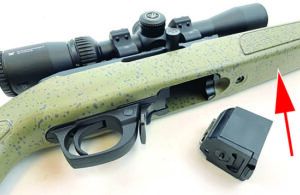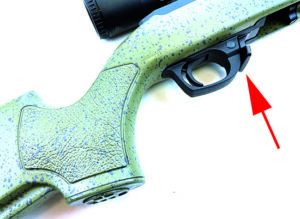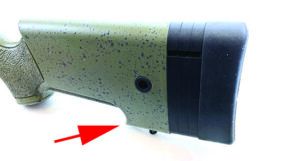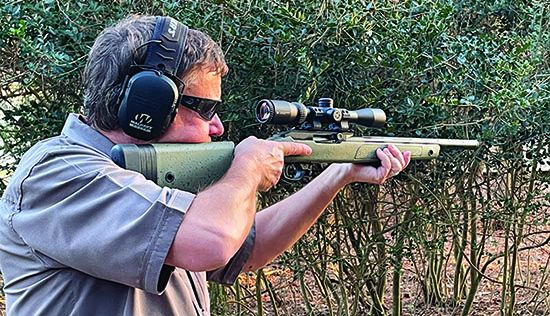Semi-automatic 22 LR rifles are a mainstay with shooters and hunters. These rimfire rifles are fun to shoot and offer fast follow-up shots when plinking, small-game hunting, informal precision shooting, or pinging steel plates. Plus, ammo is inexpensive. However, not all 22 rimfire rifles can do all things well. That’s why there are specialized models. For this match up, we wanted to look at 22 LR semi-auto rifles that could easily be used for hunting as well as dabble in fast shooting competition, or maybe punch tiny groups at the local range for bragging rights among our pals. We didn’t want to feel undergunned or overgunned in the scenarios mentioned above, but we wanted a moderately priced do-all type of rifle/scope combo. Must-haves for these rifle/scope combos were: accuracy, a trigger that would not force us to cuss, comfortable stock, and mounting an optic needed to be easy and simple. If the rifle were further customizable, it earned bonus points. The three rifles in this review are the Bergara BXR, Ruger 10/22 Target, and Savage A22.
How We Tested
We mounted scopes on the rifles and zeroed in at 50 yards. The Savage came with a two-piece Weaver base mounted on the receiver, and it was simple and easy to mount the optic. Mounting a scope on the Bergara was even easier because it came with a Picatinny rail screwed on to the receiver. The Ruger came with a base. Removing the base plug screws were a pain because the finish was heavy and clogged up the tiny screwhead slots. After that, mounting the rail and the scope was a simple task.
A few issues back we tested a Vortex Crossfire II 2-7x32mm rimfire SFP scope ($149; OpticsPlanet.com) with a simple V-Plex MOA reticle similar to a Duplex reticle. We become partial to this scope. We used Vortex Pro Series 1-inch medium-height rings ($79; MidwayUSA.com) to mount the scope to the Savage and the Bergara. On the Ruger, we placed a Hawke Vantage IR 3-9x40mm scope ($159; OpticsPlanet.com) with a Rimfire 22 HV reticle. Because the Ruger came with a Weaver-style scope base adapter that also allows use of claw-style rings, we used NCStar 3⁄8-inch dovetail 1-inch rings ($13; Amazon.com) to attach the scope to the base.

The Ruger is a straight-comb-stock rifle, like an AR-15, and the Hawke Vantage setup offered the correct height for proper eye alignment and shooting comfort. The reticle is a BDC (Bullet Drop Compensating) style reticle calibrated for 22 LR ammunition loaded with 36- to 40-grain bullets with a muzzle velocity range of 1235 to 1260 fps. You need to dial the optic to 9x to use the BDC feature, and it worked well out to 100 yards. There are no hash marks on the horizontal strata to compensate for wind, though there is 2.1-minutes-of-angle (MOA) space between the vertical strata to the thicker duplex horizontal strata, so this can be used to determine a hold. The BDC hash marks are labeled out to 200 yards in 25-yard increments. The reticle also illuminates red or green with five levels of brightness intensity.
Clarity was good for both scopes at this price point. Both scopes have screw-on turret caps, and we would be sure they are screwed on if we were in the field and it started to rain. In our opinion, the BDC reticle in the Hawke is more practical than the V-Plex reticle in the Vortex if you plan on long-range shooting. From plinking distance out to 100 yards, these scopes work well and won’t break the bank.
We purposefully didn’t bore-sight the rifles because ammo was cheap and we wanted to test the turrets and adjustment accuracy on the scopes. Zeroing all the rifles was an easy task. The clicks were solid and easily rotated with our fingers. The direction was clearly marked on both scopes. With the rifles zeroed, we used a bench and rest to gather accuracy data. We also fired the rifles offhand to get a feel for how they would be in the field. Ammunition was inexpensive CCI Blazer with a 38-grain LRN bullet, Federal Auto Match with a 40-grain solid lead bullet, and hot CCI Stangers using 32-grain copper-plated hollow points. Here’s how everything performed at the range:
Bergara BXR Steel BXR001 22 LR
$560
Gun Tests grade: A- [our pick]
The BXR is an accurate and excellent all-round 22 rimfire rifle with a stock that is comfortable to shoot off a bench, prone, or offhand. It is suitable for a variety of shooter statures. The magazine was tricky to insert into the magwell.

| Action Type | Semi-automatic |
| Overall Length | 34.5 in. |
| Barrel Length | 16.5 in. |
| Twist Rate | 1:16 in. |
| Muzzle Device | None, threaded |
| Sights | Optics ready, 30-MOA Picatinny rail |
| Weight Unloaded | 5.2 lbs. |
| Weight Loaded | 5.3 lbs. |
| Capacity | 10 |
| Stock | Synthetic |
| Stock Length of Pull | Adjustable, 13-14 in. |
| Buttplate | Rubber |
| Action Finish | Matte black |
| Barrel Finish | Matte black |
| Magazine Type | Detachable, plastic, 10-rnd. rotary box |
| Trigger Pull Weight | 3.5 lbs. |
| Safety | Manual |
| Accuracy Guarantee | None stated |
| Warranty | Lifetime, original owner |
| Telephone | (800) 320 8767 |
| Website | BergaraUSA.com |
| Made In | U.S. |
The Bergara BXR is similar to a Ruger 10/22 in many ways. The BXR features a blow-back action very much like a 10/22 and is compatible with Ruger aftermarket triggers, rotary magazines, and more. Receiver markings were clean and easy to read.
The BXR integrates a 30-MOA Picatinny rail into the top of the receiver that runs past the point where the barrel attached to the receiver. We liked this rail because it allows many different mounting locations and is compatible with any optic — scopes or red dots — that are Picatinny-rail friendly. The Vortex scope was easy and simple to mount.

The BXR Steel is fitted with a heavy-taper 16.5-inch steel barrel. Shallow flutes are milled into the barrel for more surface-area cooling. Weight is 5.2 pounds. The balance of this rifle is closer to your support hand, so it is less lively when shooting offhand. The muzzle is threaded, waiting for the device of your choosing.
The charging handle is fixed but rounded, so your finger rolls off the handle when racking it back to load the gun. The crossbolt safety is built into the front of polymer trigger housing.
The magazine release is oversized and can be reached and pressed with the trigger finger. Inserting the Bergara magazine was a tight fit and took a bit of finesse to seat the magazine. The magazine did not drop free and required us to use two fingers from our support hand to pluck the magazine out of the magwell while depressing the magazine release. Not a fast-loading rifle, in our opinion. The Bergara magazine also needed to be plucked out of the Ruger Target. The Ruger magazine was easier to insert in the Bergara’s magwell, but still needed to be pulled out manually. The Bergara magazine was easy to load all the way to the tenth round.
The polymer trigger is smooth but has a slight texture to it so your finger stays put when shooting fast. Pull weight measured 3.5 pounds with a very short take up until you hit the wall and a clean, crisp break. Reset was about 1⁄4 inch. We liked the trigger.

The polymer stock is like a scaled-down version of Bergara’s HMR Pro except without the adjustable cheek riser. The finish is an OD green with gray splatter contrasting the matte-black receiver, trigger guard, and barrel. It is sharp looking. The rubber buttpad is rounded and sticky so the rifle is fast to shoulder and stays put. Three half-inch spacers allow the user to adjust the length of pull from 13 to 14 inches. No need to remove those long buttpad screws either. Slots in the spacer allow you to loosen the screws then rotate the spacers out or in. The toe was flat for easy use with a toe mini-bag, and the bottom edge was hooked so you can use your support hand to press the stock into your shoulder when shooting prone or from the bench. The gripping areas have plenty of texture for a sure grip. We liked that the fore end was flat for stable shooting off a bag. A nice feature are the QD flush cups on both sides of the stock for attaching a sling. There are also traditional sling studs built into the bottom of the stock. The problem with just having sling studs is you can’t use both a sling and bipod at the same time. Bergara fixed this issue.
Getting behind the BXR, we found it was comfortable to shoot from a bench. With the Vortex scope and the nice trigger, the smallest five-shot group measured 0.45 inches with the inexpensive CCI Blazer ammo; average was 0.48 inches. Next best was Federal Auto Match at 0.59 inches; average was 0.63 inches. The CCI Stangers’ best group was 0.89 inches and average was 0.98 inches. Overall average across all ammo was 0.69 inches, making this the most accurate rifle. Keep in mind, the difference in group size differed by .08 inches between the Bergara and Savage, and .02 inches between the Bergara and the Ruger. Any way you look at it, accuracy was a hundredths of an inch difference between all three rifles.
Shooting offhand, the BXR’s weight was on our support hand. It did not swing as easily as the Ruger Target, our shooters said.
Our Team Said: The BXR was accurate and easy to shoot well. The stock was comfortable and adjustable and we liked it a lot, except when inserting magazines. A plus is that the Bergara is compatible with many aftermarket Ruger 10/22 parts. This rifle is a good option as a high-quality, accurate do-all rifle. It would be an excellent choice for plinking, small-game hunting, and steel-plate matches if a red-dot optic is mounted.
| 22 LR RANGE DATA | |||
| CCI Blazer 38-grain LRN | Bergara BXR Steel | Ruger 10/22 Target | Savage A22 BNS-SR |
| Average Velocity | 1239 fps | 1240 fps | 1135 fps |
| Muzzle Energy | 129 ft.-lbs. | 130 ft.-lbs. | 109 ft.-lbs. |
| Smallest Group | 0.45 in. | 0.55 in. | 0.76 in. |
| Average Group | 0.48 in. | 0.70 in. | 0.81 in. |
| Federal Auto Match 40-grain Solid | Bergara BXR Steel | Ruger 10/22 Target | Savage A22 BNS-SR |
| Average Velocity | 1142 fps | 1143 fps | 1139 fps |
| Muzzle Energy | 116 ft.-lbs. | 116 ft.-lbs. | 115 ft.-lbs. |
| Smallest Group | 0.59 in. | 0.49 in. | 0.49 in. |
| Average Group | 0.63 in. | 0.60 in. | 0.57 in. |
| CCI Stangers 32-grain Copper Plated HP | Bergara BXR Steel | Ruger 10/22 Target | Savage A22 BNS-SR |
| Average Velocity | 1515 fps | 1523 fps | 1540 fps |
| Muzzle Energy | 163 ft.-lbs. | 165 ft.-lbs. | 169 ft.-lbs. |
| Smallest Group | 0.89 in. | 0.78 in. | 0.72 in. |
| Average Group | 0.98 in. | 0.84 in. | 0.95 in. |
How we tested: To collect accuracy data, we fired five-shot groups at 50 yards from a bench using a rest. We used a Garmin Zero C1 Pro chronograph to record velocities.
Written and photographed by Robert Sadowski, using evaluations from Gun Tests Team members. GT

























